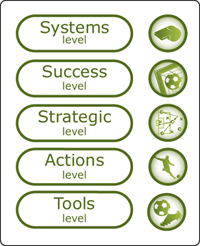From Strategy to Tools: The day to day application of a sustainability lens
 Many of the questions we are asked about sustainability strategy focus on implementation: “Yes, we have goals now, but what do we actually DO? How do we change the way people think and help people who are not Green Team members to apply a sustainability lens??”
Many of the questions we are asked about sustainability strategy focus on implementation: “Yes, we have goals now, but what do we actually DO? How do we change the way people think and help people who are not Green Team members to apply a sustainability lens??”
This is the challenge of moving from the strategic to the operational and building tactical support for everyday work. So how does that happen?
One of the ways we’ve seen this work is through the development of tools that help people to apply a sustainability lens to their work. Here’s how it works:
You may already be familiar with the 5 level model for planning in complex systems. Basically it says that to design and execute well it’s helpful to know 5 things: firstly, the system in which you are working and the rules by which that system operates, and what success in that system looks like. Knowing this, we can then develop strategies to arrive at success in the system. Once strategies are developed, we undertake actions aligned to achieve these strategies. And, we may need tools to support our actions to achieve our strategies to arrive at success in the system. As the Swedes, say – clear as sausage water!
Essentially the message is this: tools are strategic when we know where we want to go (success) and the game and playing field on which we operate (the system). They should be developed to help achieve strategies that are aligned toward that vision. When we build tools with this intention, they help us to get where we want to go.
Here’s an example: ISL Engineering and Land Services is a multi-service engineering firm who has done significant sustainability work. They have strategic goals aligned with principles of sustainability, key milestones and key performance indicators set, and multiple actions underway that are associated with each goal. They have now turned their focus to helping their engineers apply a sustainability lens to projects. Beginning with water treatment plants, they have developed a tool that helps their engineers: (i) understand the biggest sustainability challenges associated with treatment plants when viewed through the lens of the principles across the full lifecycle of the plant; and (ii) assess at a technical level the relative sustainability performance of various designs for a given treatment plant. This assessment highlights areas for improvement (from a sustainability perspective) and areas of strength for each design option. This helps seed client conversations around sustainability and provides capacity building at a discipline level.
Tools are often a critical piece of any sustainability journey. Tools can help apply a sustainability lens to very specific aspects of a journey. However, they become strategic when helping us to undertake actions (design a sustainability water plant) to fulfill strategies (backcasting from success) to arrive at success (goal: “our professional design solutions consistently demonstrate local knowledge, a high level of technical expertise, a deep understanding of client needs and an unrelenting commitment to sustainability”) in the system (water treatment plants within society within the biosphere). In this way, we ensure that our resources are well directed and efficiently used.
Time to tool up!
To discuss this tool or others in more detail, please contact our advisory team at sbrooks(at)naturalstep.ca
- Log in to post comments

